Abstract
The subclass specificities of antiviral immunoglobulin G (IgG) produced in response to herpes simplex and varicella-zoster virus infections were investigated. IgG1 and IgG3 with anti-herpes simplex virus activity were seen in patients with primary and reactivated disease, as well as in healthy seropositive subjects and in immunoglobulin preparations. IgG4 was occasionally seen alone or together with IgG1 and IgG3 in patients. In varicella, IgG3-specific antiviral antibodies were predominant, whereas in zoster, IgG1 was the dominant subclass.
Full text
PDF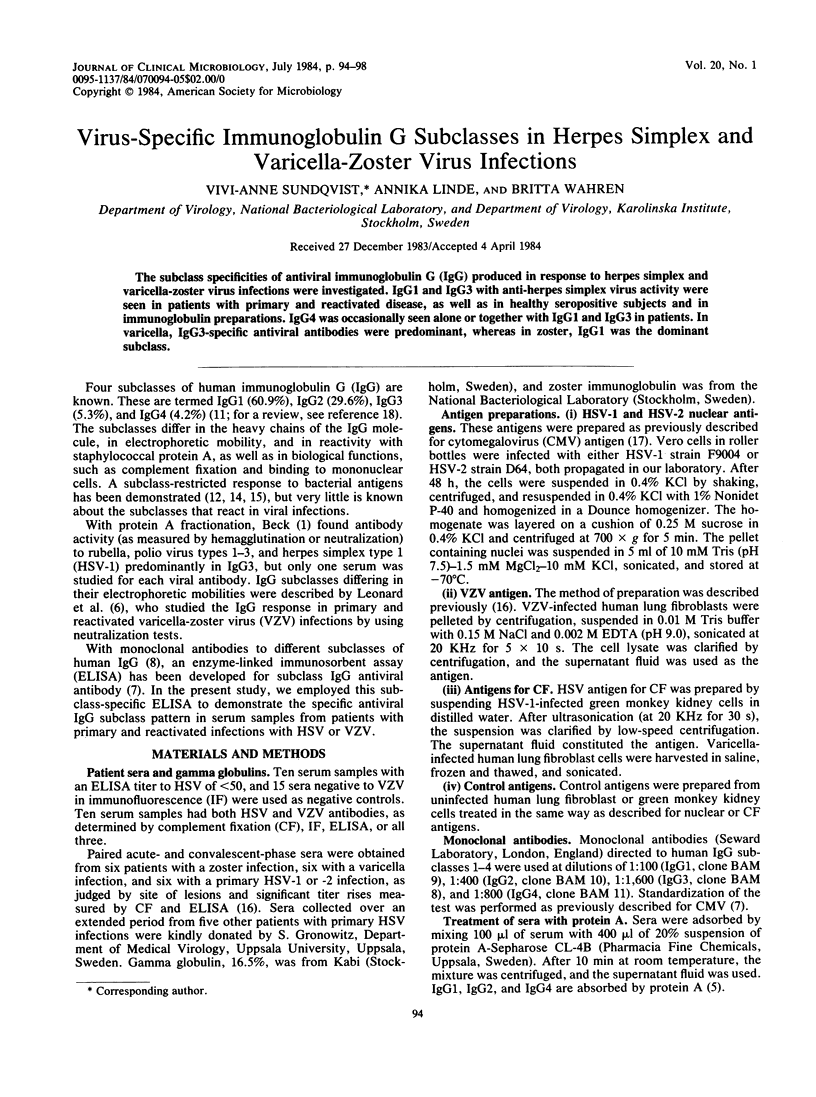
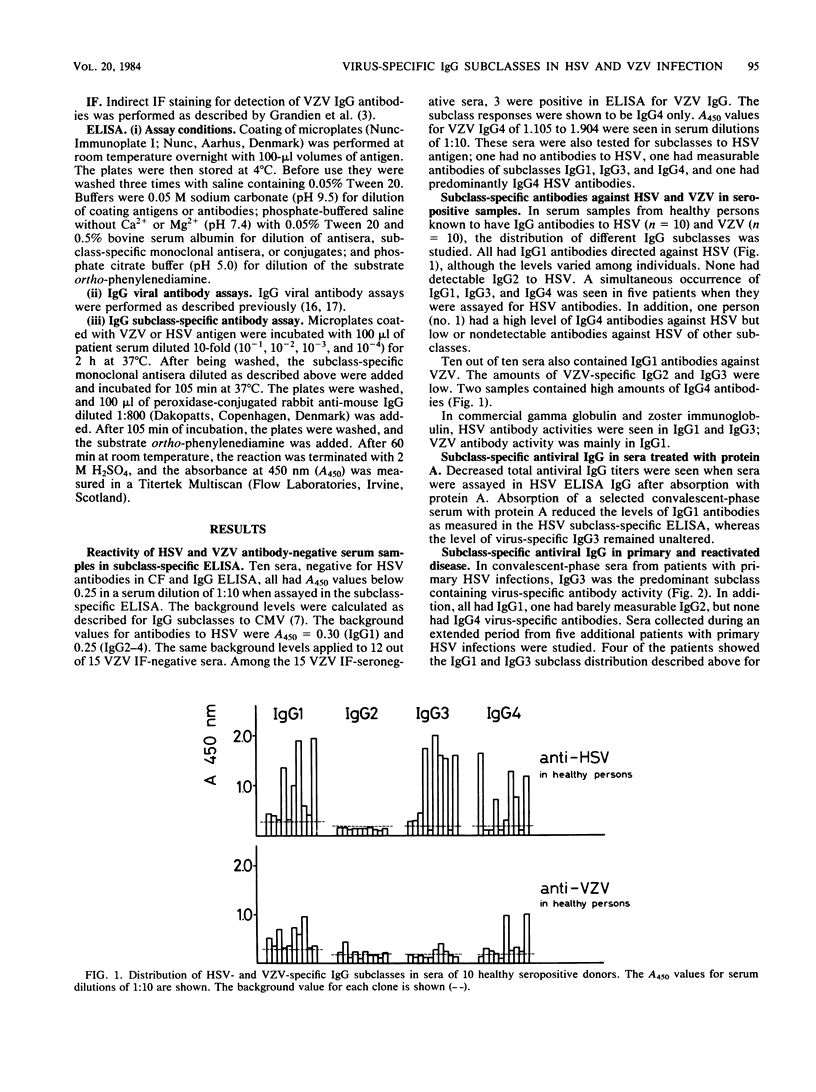
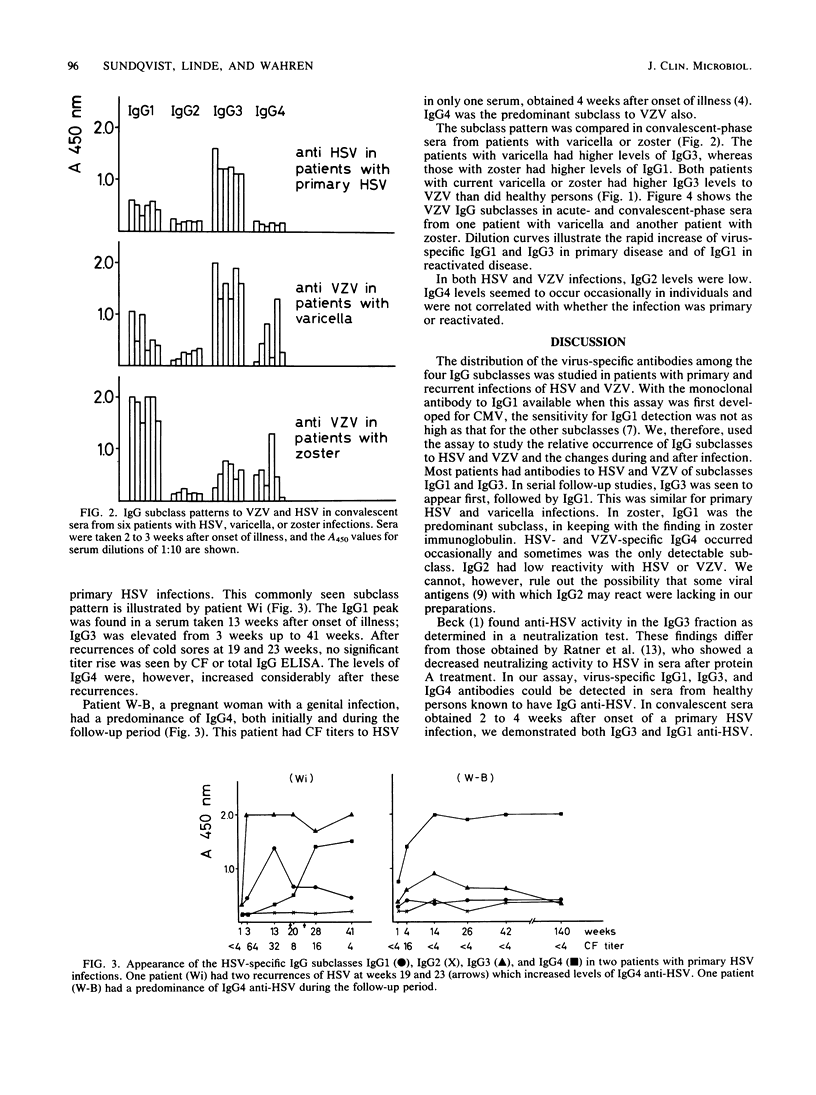
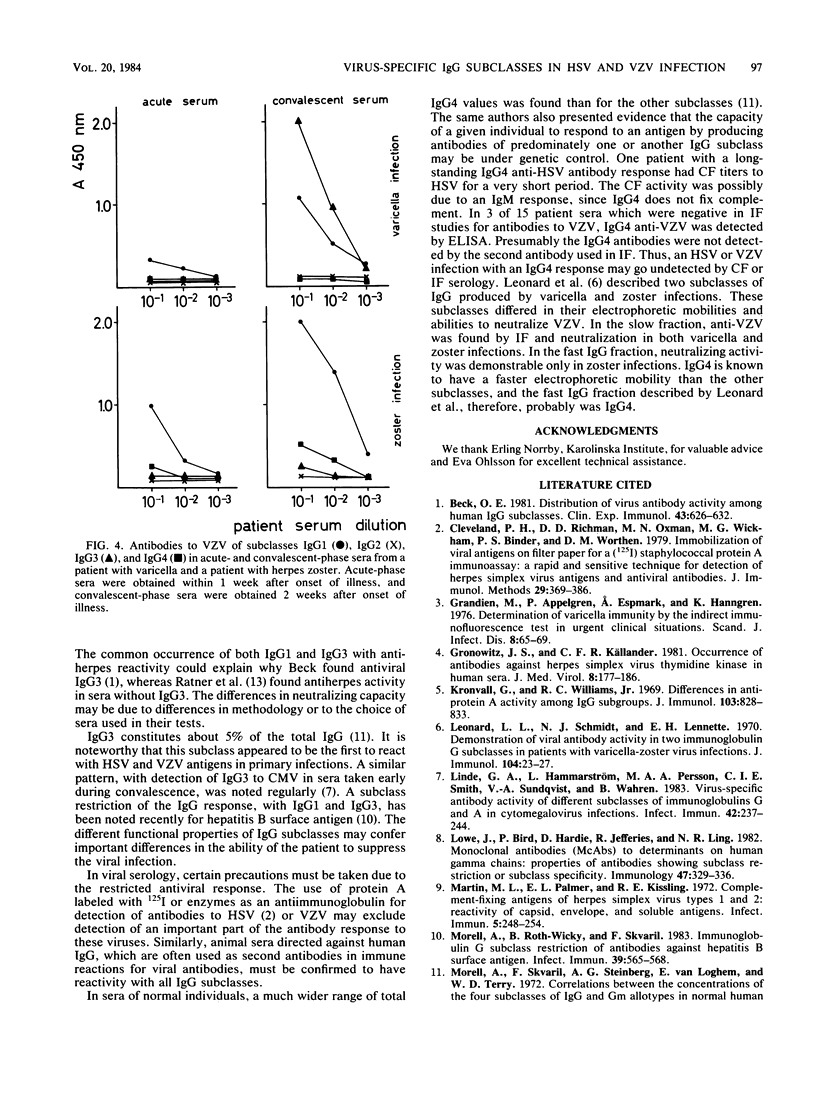
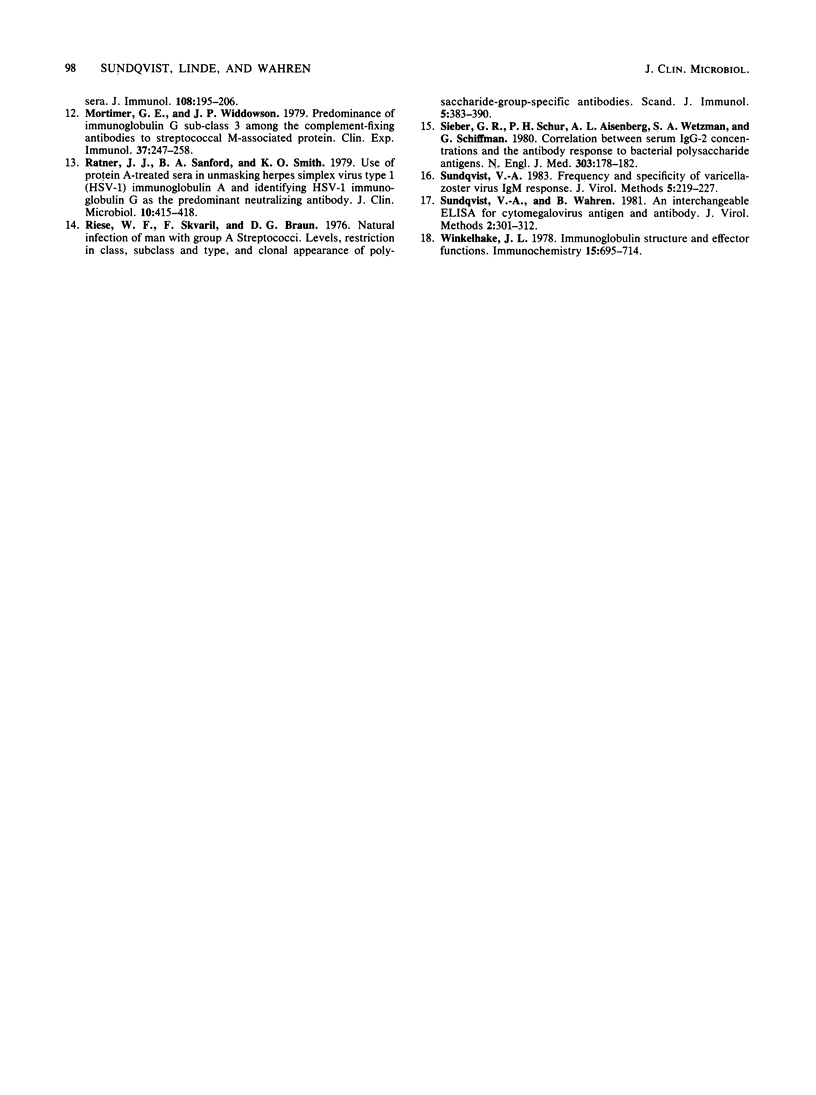
Selected References
These references are in PubMed. This may not be the complete list of references from this article.
- Beck O. E. Distribution of virus antibody activity among human IgG subclasses. Clin Exp Immunol. 1981 Mar;43(3):626–632. [PMC free article] [PubMed] [Google Scholar]
- Cleveland P. H., Richman D. D., Oxman M. N., Wickham M. G., Binder P. S., Worthen D. M. Immobilization of viral antigens on filter paper for a [125I]staphylococcal protein A immunoassay: a rapid and sensitive technique for detection of herpes simplex virus antigens and antiviral antibodies. J Immunol Methods. 1979;29(4):369–386. doi: 10.1016/0022-1759(79)90008-5. [DOI] [PubMed] [Google Scholar]
- Grandien M., Appelgren P., Espmark A., Hanngren K. Determination of varicella immunity by the indirect immunofluorescence test in urgent clinical situations. Scand J Infect Dis. 1976;8(2):65–69. doi: 10.3109/inf.1976.8.issue-2.01. [DOI] [PubMed] [Google Scholar]
- Gronowitz J. S., Källander C. F. Occurrence of antibodies against herpes simplex virus thymidine kinase in human sera. J Med Virol. 1981;8(3):177–186. doi: 10.1002/jmv.1890080304. [DOI] [PubMed] [Google Scholar]
- Kronvall G., Williams R. C., Jr Differences in anti-protein A activity among IgG subgroups. J Immunol. 1969 Oct;103(4):828–833. [PubMed] [Google Scholar]
- Leonard L. L., Schmidt N. J., Lennette E. H. Demonstration of viral antibody activity in two immunoglobulin G subclasses in patients with varicella-zoster virus infection. J Immunol. 1970 Jan;104(1):23–27. [PubMed] [Google Scholar]
- Linde G. A., Hammarström L., Persson M. A., Smith C. I., Sundqvist V. A., Wahren B. Virus-specific antibody activity of different subclasses of immunoglobulins G and A in cytomegalovirus infections. Infect Immun. 1983 Oct;42(1):237–244. doi: 10.1128/iai.42.1.237-244.1983. [DOI] [PMC free article] [PubMed] [Google Scholar]
- Lowe J., Bird P., Hardie D., Jefferis R., Ling N. R. Monoclonal antibodies (McAbs) to determinants on human gamma chains: properties of antibodies showing subclass restriction or subclass specificity. Immunology. 1982 Oct;47(2):329–336. [PMC free article] [PubMed] [Google Scholar]
- Martin M. L., Palmer E. L., Kissling R. E. Complement-fixing antigens of herpes simplex virus types 1 and 2: reactivity of capsid, envelope, and soluble antigens. Infect Immun. 1972 Feb;5(2):248–254. doi: 10.1128/iai.5.2.248-254.1972. [DOI] [PMC free article] [PubMed] [Google Scholar]
- Morell A., Roth-Wicky B., Skvaril F. Immunoglobulin G subclass restriction of antibodies against hepatitis B surface antigen. Infect Immun. 1983 Feb;39(2):565–568. doi: 10.1128/iai.39.2.565-568.1983. [DOI] [PMC free article] [PubMed] [Google Scholar]
- Mortimer G. E., Widdowson J. P. Predominance of immunoglobulin G sub-class 3 among the complement-fixing antibodies to streptococcal M-associated protein. Clin Exp Immunol. 1979 Aug;37(2):247–258. [PMC free article] [PubMed] [Google Scholar]
- Ratner J. J., Sanford B. A., Smith K. O. Use of protein A-treated sera in unmasking herpes simplex virus type 1 (HSV-1) immunoglobulin A and identifying HSV-1 immunoglobulin G as the predominant neutralizing antibody. J Clin Microbiol. 1979 Oct;10(4):415–418. doi: 10.1128/jcm.10.4.415-418.1979. [DOI] [PMC free article] [PubMed] [Google Scholar]
- Riesen W. F., Skvaril F., Braun D. G. Natural infection of man with group A streptococci. Levels; restriction in class, subclass, and type; and clonal appearance of polysaccharide-group-specific antibodies. Scand J Immunol. 1976;5(4):383–390. doi: 10.1111/j.1365-3083.1976.tb00292.x. [DOI] [PubMed] [Google Scholar]
- Siber G. R., Schur P. H., Aisenberg A. C., Weitzman S. A., Schiffman G. Correlation between serum IgG-2 concentrations and the antibody response to bacterial polysaccharide antigens. N Engl J Med. 1980 Jul 24;303(4):178–182. doi: 10.1056/NEJM198007243030402. [DOI] [PubMed] [Google Scholar]
- Sundqvist V. A. Frequency and specificity of varicella zoster virus IgM response. J Virol Methods. 1982 Nov;5(3-4):219–227. doi: 10.1016/0166-0934(82)90012-x. [DOI] [PubMed] [Google Scholar]
- Sundqvist V. A., Wahren B. An interchangeable ELISA for cytomegalovirus antigen and antibody. J Virol Methods. 1981 Apr;2(5):301–312. doi: 10.1016/0166-0934(81)90029-x. [DOI] [PubMed] [Google Scholar]
- Winkelhake J. L. Immunoglobulin structure and effector functions. Immunochemistry. 1978 Sep;15(9):695–714. doi: 10.1016/0161-5890(78)90044-5. [DOI] [PubMed] [Google Scholar]


